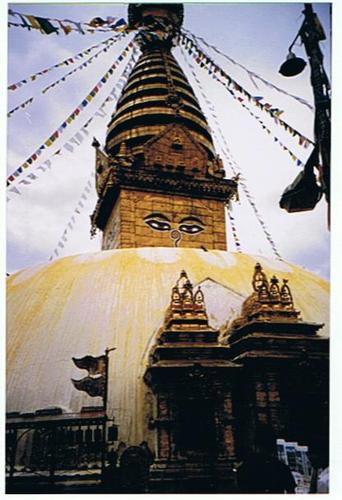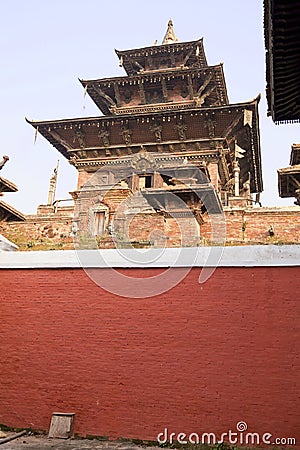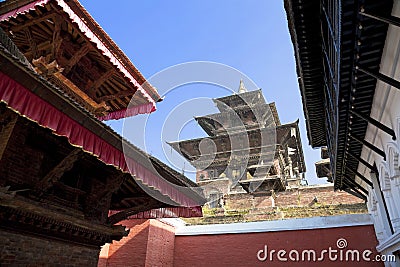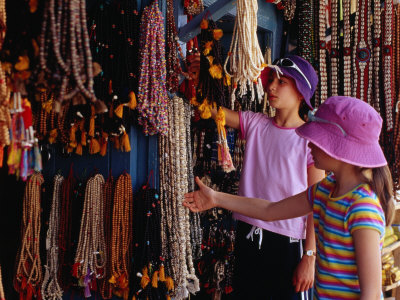Towering like a lighthouse over the old town, this white, minaret-like tower is a useful landmark near the main post office. The views from 61.88m up - 213 steps above the city - are the best you can get. There is a small Shiva shrine right at the very top.
The tower was originally built in 1826 by the Rana prime minister, Bhimsen Thapa, as part of the city's first European-style palace. It was rebuilt after being severely damaged in the 1934 earthquake. The nearby Sundhara water tank lends its name to the district.
Description
Construction of the huge three-tiered Taleju Mandir heralded a new phase in the architecture of the Kathmandu Valley. It was the first temple erected with more than two roofs and the first to be raised on a tall stepped platform. It is said that the mandir was built in the shape of a yantra on the advice of Taleju herself and that she appeared to the King at the dedication ceremony disguised as a bee.
Hobbies & Activities category: Hindu or Jain site or artifact collection
Image of Taleju Mandir Temple at UNESCOs World Heritage Site of Kathmandu Durbar Square, Nepal
Patan (Lalitpur) Durbar Square and old city, Kathmandu Valley, Nepal
Kathmandu Durbar Square
It is easy to be over whelmed by the seemingly uncountable monuments in the Kathmandu Durbar Square. The house of the Living Goddess, the ferocious Kal Bhairab, the red monkey god, and hundreds of erotic carvings are a few examples of the sights at the Square! The buildings here are the greatest achievements of the Malla dynasty, and they resulted from the great rivalry between the three palaces of Kathmandu, Patan, and Bhaktapur. The Valley was divided among the children of Yaksya Malla. For visitors today, and for the Nepalese, it was serendipitous that they, and later their offsprings, began an artistic warfare trying to outdo each other in splendid constructions. Kings copied everything their neighbours built in an even grander style. A visitor who wanders around the Square will see a round temple in the pagoda architectural style, the temple of Goddess Taleju (who played dice with King Jaya Prakash Malla), and an image of Shiva and Parbati sitting together among the many monuments. The Square is teeming with colorful life. Vendors sell vegetables, curios, flutes, and other crafts around the Kastamandap rest house. This rest house is said to have been built with the wood of a single tree and is the source from which the Kathmandu Valley got its name. Nearby are great drums which were beaten to announce royal decrees. All woodcarvings, statues, and architecture in this area are exceptionally fine, and Kathmandu Durbar Square is among the most important sights for travellers to see.
Swayambhu Nath

The history of the Valley, according to the legends, begins with Swayambhu, or the "the self existent". In times uncharted by history, Bodhisattva Manjusri came across a beautiful lake during his travel. He saw a lotus that emitted brilliant light at the lake's center, so he cut a gorge in a southern hill and drained the waters to worship the lotus. Men settled on the bed of the lake and called it the Kathmandu Valley. From then on, the hilltop of the Self existent Lord has been a holy place.
Swayambhu's light was covered in time because few could bear its intensity. By the thirteenth century, after many layers were added to the original structure that enveloped the Lord's power, a dome like shape had been acquired. The stupas central mast was damaged and replaced at that time. Peripheral sources of power were discovered on the hilltop as well and stupas, temples, and rest houses were built to honour them. Images of important deities, both Buddhist and Hindu, were also installed. Today, age-old statues and shrines dot the stupa complex. Behind the hilltop is a temple dedicated to Manjusri of Saraswati - the goddess of learning.
Swayambhu is, perhaps, the best place to observe the religious harmony in Nepal. The stupa is among the most ancient in this part of the world, and its worshippers are diverse from Newar nuns, Tibetan monks, and Brahmin priests to lay Buddhists and Hindus. The largest image of the Sakyamuni Buddha in Nepal is in a monastery next to the stupa. Other monasteries here have huge prayer wheels, fine Buddhist paintings, and special butter lamps which may be lit after presenting monetary offerings. Swayambhu is a major landmark of the Valley and looks like a beacon below the Nagarjun hill. It provides an excellent view of the Kathmandu Valley. Devotees have climbed the steps on the eastern side for centuries. Statues of the Buddha, mini stupas, monasteries and monkeys make the climb to Swayambhu ? which is fairly steep worthwhile. But for someone who is physically disabled or is pressed for time, the western road allows you to get off your transport almost at the base of the stupa.
Boudha Nath
Boudhanath is among the largest stupas in South Asia, and it has become the focal point of Tibetan Buddhism in Nepal. The white mound looms thirty-six meters overhead. The stupa is located on the ancient trade route to Tibet, and Tibetan merchants rested and offered prayers here for many centuries. When refugees entered Nepal from Tibet in the 1950s, many of them decided to live around Bouddhanath. They established many gompas, and the "Little Tibet" of Nepal was born. This "Little Tibet" is still the best place in the Valley to observe Tibetan lifestyle. Monks walk about in maroon robes. Tibetans walk with prayer wheels in their hands, and the rituals of prostration are presented to the Buddha as worshippers circumambulate the stupa on their hands and knees, bowing down to their lord. Many people believe that Bouddhanath was constructed in the fifth century, but definite proof is lacking. The stupa is said to entomb the remains of a Kasyap sage who is venerable both to Buddhists and Hindus. One legend has it that a woman requested a Valley king for the donation of ground required to build a stupa. She said she needed land covered by one buffalo's skin and her wish was granted by the King. She cut a buffalo skin into thin strips and circled off a fairly large clearing. The king had no choice but to give her the land.
Pashupati Nath
Pashupatinath is the holiest Hindu pilgrimage destination in Nepal. There are linga images of Shiva along with statues, shrines, and temples dedicated to other deities in the complex. A temple dedicated to Shiva existed at this site in AD 879. However, the present temple was built by King Bhupatindra Malla in 1697. A gold-plated roof, silver doors, and woodcarvings of the finest quality decorate the pagoda construction. Guheswari Temple, restored in AD 1653, represents the female "force". It is dedicated to Satidevi, Shiva's first wife, who gave up her life in the flames of her father's fire ritual.
A circuit of the Pashupati area takes visitors past a sixth century statue of the Buddha, an eighth-century statue of Brahma the creator and numerous other temples. Some other places to visit are Rajrajeswari Temple, built in 1407, Kailas with lingas more than 1,400 years old, Gorakhnath temple, and the courtyard of Biswarup. There are rows of Shiva shrines and Hindu pilgrims from all over South Asia offering puja worship to Shiva, tile Lord of Destruction.
The Bagmati River flows close by and the Arya Ghat cremation grounds are here. We strongly advise photographers not to take photos of cremations and of bereaved families. Sadhus, sages who follow the lifestyle of Shiva, may be seen covered in ashes and lion cloths. They ask for money in case you want to take their photos. The main Pashupatinath courtyard may be entered by those of Hindu faith only.
Indrachowk, a square, the courtyard of Indra named after an ancient Hindu deityis walking distance far from Durbar square. Akash Bhairab temple, a three storey temple lies at Indrachowk the main market avenue of the Kathmandu city. The image of Akash Bhairav is displayed outside the temple for a week during Indrajatra, the festival of Indra the God of Rain.
Freak Street
The road running off Durbar square to the south, has since 1973 rejoiced in the unofficial title of Freak street. It used to be wild jumble of cheap hotels, restaurant, and all the freaky travellers.
White Machhendra Nath
The temple is situated at Machhendra Bahal near Indrachowk. This two storeyed temple was built by Yaksha Malla in 1500 AD The chariot festival of white Machendra Nath (the god of mercy) is annually celebrated in Kathmandu Valley. The traditional music is always played in the evening at this temple which is open to westerners.
Ason
Ason is one of the busiest squares in Kathmandu and has six roads radiating from it. The three storeyed high pagoda styled Annapurna temple (goddess of food grains) is situated at Ason. Another two storeyed temple is dedicated to Lord Ganesh.
Thamel
Thamel area has recently emerged as the most popular tourist area of Kathmandu. Thamel is 15 to 20 minutes walk from the center of Kathmandu. It is amazing to see how this area has become the centre for budget travellers in recent years. Thamel is clean narrow street full of mushrooming lodges, hotels for budget travellers, restaurant, bar, tourists oriented shops and bustling with activities.
Singa Durbar
Singha Durbar is a grand, imposing palace built in the neo-classical style. It was once the private residence of Rana Prime Ministers and is now the official seat of government. It used to be a huge building with many courtyards; however, most of it was destroyed by fire and only the western half has been rebuilt.
Dharahara
Also known as Bhimsen Stambha (Tower), Dharahara is a 50.5 meter tower built by Prime Minister Bhimsen Thapa in 1832. Situated near the General Post Office, the tower is one of Kathmandu's best known monuments. From the top of the tower, one has a panoramic view of the whole Kathmandu Valley. It is not open for the public.
Narayanhiti Royal Palace















No comments:
Post a Comment